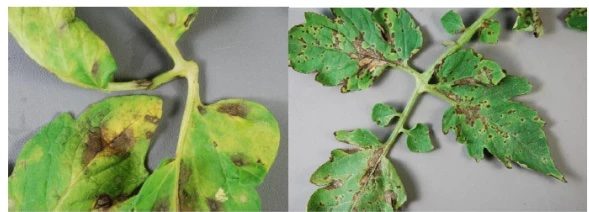
Fact Sheets And Publications

Leaf Spot Diseases in Garden Tomatoes
Description, Host Range, and Diagnosis
Foliar leaf spot diseases and blights of tomato plants are common problems for tomato growers in Delaware and the Mid-Atlantic States. Pathogens survive in plant debris or weed hosts, and are favored by humid weather and moderate temperatures.
The most common are early blight caused by the fungus Alternaria solani, and Septoria blight or leaf spot, caused by Septoria lycopersici. Alternaria causes a brown to black leaf spot that expands in a zonate pattern, as spores are produced in successive cycles on the leaves.
Spots appear on older leaves first, often coalesce, and progress up the plant during the season. Septoria leaf spots begin as small dark spots that have a yellow area or halo around the dark spot. Septoria begins to show on lower leaves first. Small dark fruiting bodies can be seen in the center of leaf spots.
Bacterial leaf spot will appear rapidly, as more diffuse, round, water-soaked spots, with a yellow halo around the spot. No fruiting bodies will be seen if it is bacterial spot.
Late blight is a severe leaf spot, caused by a fungus-like Oomycete pathogen. Late blight affects tomato and potato, and causes a dark, greasy spot that spreads rapidly, and can kill entire stems and plants if left unmanaged. The term blight infers rapid spreading death of plant tissue. Anthracnose is another fungal leaf disease of tomato, which can spread to developing fruit. Viruses such as tomato spotted wilt (TSWV) can also affect leaves and fruit. Leaf roll is usually due to an environmental stress such as high temperature or water imbalance. Tomatoes are often affected by drift from lawn herbicides.


Most fungal leaf spots are very host specific, and many that are found on tomato can affect members of other solanaceous plants such as potato, pepper, and eggplant, or weeds such as nightshade. Alternaria, Septoria, Xanthomonas, or Phytophthora can spread to fruit and be damaging to the harvest.
Management
Management in the home garden or on small farms is best accomplished by sanitation, removing old plant debris from previous years, removing affected plant foliage early in infection, avoiding over-crowding, increasing air circulation, maintaining good plant vigor, and reducing stress on susceptible hosts. Removing nearby weed hosts may also help slow the spread of disease. Watering during times of drought, avoiding overhead water on the leaves, mulching, taking care to avoid wounding, and avoiding chemical injury, are all good practices. Mixed plantings of vegetables, rotation in garden areas, and mixing in of flower species helps to avoid the monoculture which may aid in spread of disease.
Control of plant diseases, including those on tomato, is best accomplished by "starting clean and staying clean", with clean healthy plants and good sanitation practices in the garden. Clean seed, rotation, sanitation, and removal of volunteer plants and weeds are best management practices. Plastic or organic mulches may help to lower humidity in the plant canopy and reduce infection. Fungicide treatments are applied preventatively on the foliage, and must be applied according to the label. Products containing chlorothalonil, mancozeb, or copper are effective against many diseases of tomato, to protect new foliage and fruit. Fungicides will not cure existing disease, spots will remain. There are no good controls for viruses that affect tomato such as TMV and TSWV. Few cultivars have resistance to leaf spots, but resistance is available to vascular wilt, root knot nematode, and root pathogens. Look in catalogs for VFN (Verticillium Fusarium Nematode) resistance. Heirloom varieties usually have little or no resistance to diseases.
Reference to commercial products or trade names does not imply endorsement by University of Delaware Cooperative Extension.
It is the policy of the Delaware Cooperative Extension System that no person shall be subjected to discrimination on the grounds of race, color, sex, disability, age, or national origin.
Author(s):
Nancy F. Gregory, Plant Diagnostician
Original Publication Date: 02/01/2017
UD Cooperative Extension
This institution is an equal opportunity provider.
In accordance with Federal law and U.S. Department of Agriculture policy, Cooperative Extension is prohibited from discriminating on the basis of race, color, national origin, sex, age, or disability.
